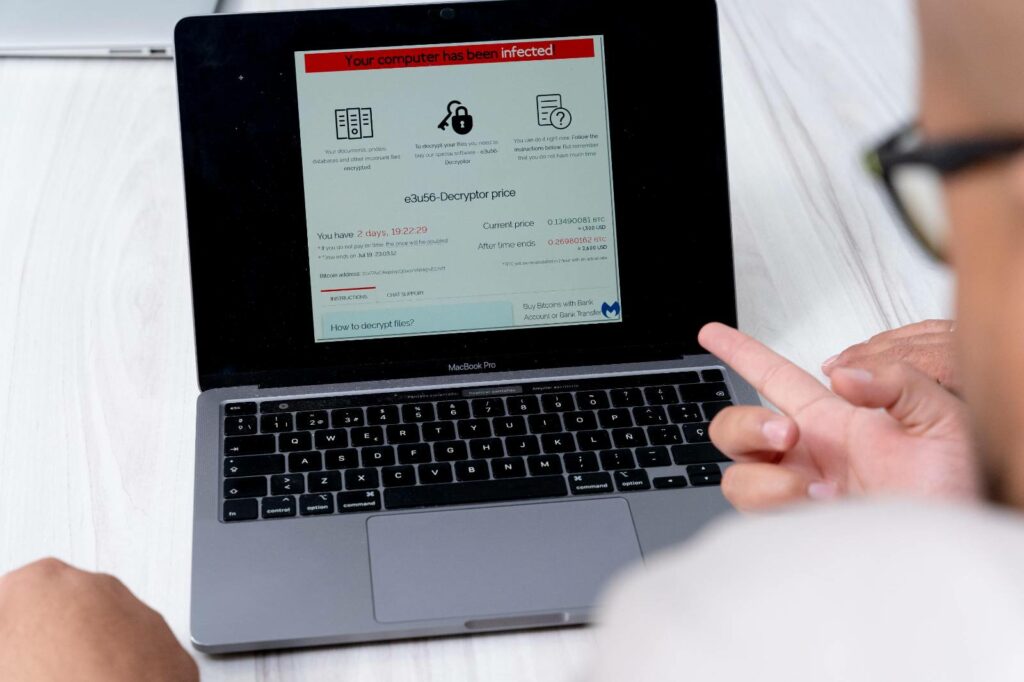Find out what to do if a ransomware attack has encrypted your data, what the first steps are, and how to isolate the affected system.

Expert Ransomware Removal
Our certified professionals have over 25 years of experience in ransomware removal, data recovery, and computer security.
First steps in responding to a ransomware attack
If you’re wondering what to do if a ransomware attack has encrypted your data, the answer is to act quickly.
The first few moments after you discover the attack are critical.
How quickly you respond can mean the difference between losing valuable data and being able to recover it.
Consider that, as reported by Statista, business downtime following a ransomware attack will increase from 15 days in the first quarter of 2020 to 24 days in the second quarter of 2022.

This translates into a significant loss of money and potential customers, and just as importantly, damage to the corporate reputation.
The key is to have a plan of action and to know what resources are available to you.
Let’s see what the key steps are.
Identify and confirm the ransomware attack
The first and most important step is to identify and confirm that you are, in fact, facing a ransomware attack that has encrypted your data.
This may include identifying ransom notes, inaccessible files, or file extensions that have been modified by the malware.
Timely confirmation allows you to move quickly to the next steps of response and mitigation.
Isolate the affected system to prevent propagation
Once an attack is confirmed, it is important to isolate the affected system to prevent the spread of ransomware.
Disconnect the device from the network and turn off Wi-Fi and Bluetooth.
This step is critical when considering what to do if a ransomware attack has encrypted your data.
Isolation prevents further damage and provides ransomware protection for other devices on the same network.
Evaluate backup integrity and availability
Before taking any further action, evaluate the integrity and availability of your backups.
Veeam reports that cybercriminals attack backup repositories 93% of the time.

The idea is to undermine the most effective method of data recovery.
If you have recent, uncompromised backups, you may be able to recover encrypted files without paying a ransom.
This step is critical, as having reliable backups puts you in a strong position when considering what to do if a ransomware attack has encrypted your data.
Steps to take to mitigate the effects of ransomware
Once you’ve evaluated your backups, consider other actions you can take to restore encrypted files.
This may include using decryption tools, if available, or consulting with cybersecurity experts about what to do if a ransomware attack has encrypted your data.
The key is to be proactive and take steps to recover from the attack as quickly as possible.
Notify the appropriate authorities and seek expert advice
It is important to notify the appropriate authorities, such as local police or national security agencies, of the attack.
This will not only help with any investigation, but may also provide additional resources and support.
In addition, seeking expert advice from HelpRansomware experts can provide further solutions on how to deal with the situation and what resources are available to you.

Immediate Ransomware Help
Don’t let ransomware hold your business hostage. Our experts are ready to recover your data and secure your systems.
Do not interact with attackers and do not pay the ransom
Even if you feel desperate, it is important not to interact directly with the attackers: never pay the ransom.
Paying the ransom does not guarantee that you will be able to decrypt ransomware files, and may even encourage further attacks.
As reported by Fortinet, 80% of organizations that paid the ransom were hit by a second attack, 65% within a month of the first.

When considering what to do if a ransomware attack has encrypted your data, remember that paying is not the answer.
Gather information and evidence for future investigation
Document everything related to the attack.
This includes screenshots, ransom notes, and any other details that may help with future investigation or identification of the attackers.
This information can be crucial for authorities and security experts in tracing the origin of the attack and preventing future incidents.
Data recovery and restoration after a ransomware attack
Once you’ve dealt with the initial attack, it’s time to focus on removing ransomware and decrypting the files.
This step is critical to getting back to normal after a ransomware attack has encrypted your data.
The recovery process begins with a thorough assessment of the compromised data: it’s critical to determine the extent of the economic and reputational damage, and to identify what data was encrypted.
This assessment will help you plan your recovery strategy and determine if you can recover your data from backups or if other methods are required.
Ransomware data recovery is a delicate process that requires precision and attention, which is why it is ideal to turn to experts like HelpRansomware.
Among other things, it is important to make sure that the ransomware has been completely removed from the system before proceeding with the recovery.
Restoring data to a still infected system could lead to reinfection.
Immediate Ransomware Help
Don’t let ransomware hold your business hostage. Our experts are ready to recover your data and secure your systems.
Restore data from trusted backups
If a ransomware attack has encrypted your data, having trusted backups becomes your lifeline.
These backups represent secure copies of your data that were created and stored at earlier times, prior to the ransomware intrusion.
Being able to access and restore from these copies can mean the difference between a quick recovery and the potential loss of valuable information.
If you have reliable backups, start the recovery process.
According to the latest Sophos report, backup recovery rates range from 55% in Italy to 87% in France.

Implement additional security and updates
After an attack, it’s an ideal time to review and strengthen your ransomware defense.
This may include installing security patches, updating software, and implementing more robust security solutions.
These steps are essential when considering what to do if a ransomware attack has encrypted your data.
Perform a forensic analysis to determine the cause and strengthen security
After addressing the immediate threat of a ransomware attack that has encrypted your data, it’s important to understand how the attack occurred and what vulnerabilities were exploited.
This step not only helps prevent future attacks, but also provides a clear view of areas where security can be improved.
Unit 42‘s research highlights the most common attack vectors:
- Phishing: 37%;
- Software vulnerabilities: 31%;
- Brute force attacks: 9%;
- Previously compromised credentials: 6%;
- Internal threats: 5%;
- Social engineering: 5%;
- Abuse of trusted tools: 4%;
- Other: 3%.

The forensic investigation therefore focuses on a detailed analysis of the affected systems, looking for traces left by the attackers.
This may include identifying suspicious files or code, analyzing system logs for anomalous activity, and looking for entry points used by the ransomware.
Preventing and protecting against ransomware attacks
Prevention is the key to protecting your assets and information from potential ransomware attacks that could encrypt your data.
Adopting proactive measures and defensive strategies is essential to mitigate risk and ensure data security for all companies hit by ransomware.
Here are some steps to consider:
- Keep all software and operating systems up to date: Attackers often exploit known vulnerabilities in outdated software, so installing security patches in a timely manner can close those entry points;
- Train and educate employees: Many ransomware attacks begin with a single click on a malicious link or attachment; training employees to recognize phishing emails or potentially harmful content can prevent many attacks;
- Implementing advanced security solutions: next-generation firewalls, antivirus software, and threat detection and response solutions can provide additional layers of protection.
Finally, creating and regularly maintaining backups is essential.
Having secure copies of your data in separate, protected locations ensures that even in the event of an attack, the information can be recovered without having to pay a ransom.

Immediate Ransomware Help
Don’t let ransomware hold your business hostage. Our experts are ready to recover your data and secure your systems.
Keep systems and software updated with the latest security patches
One of the biggest vulnerabilities cybercriminals exploit is out-of-date software.
Keeping systems and software up to date with the latest security patches is essential.
In the case of the WannaCry ransomware, for example, Comparitech reported that 26% of businesses remained vulnerable to the virus because they didn’t have patches.

This step is essential when considering what to do if a ransomware attack has encrypted your data.
Make regular backups and store them securely
Backups are your safety net.
Making regular backups and storing them in a safe place, preferably offline, ensures that you have a copy of your data in case of an emergency.
It is very important to have online and offline copies of your data in case your entire network is compromised.
Train employees on best practices for security and awareness
Employee training is critical to protect yourself from ransomware.
Many ransomware attacks are the result of human error, such as clicking on suspicious links.
Training employees on security and awareness best practices can significantly reduce the risk.
However, as Proofpoint‘s research shows, only 56% of organizations train all employees on cybersecurity.

Implement robust security solutions such as firewalls and antivirus
In addition to backups and updates, it is essential to have robust security solutions in place.
This includes firewalls, antivirus, anti ransomware, and other defenses that can identify and block threats before they can cause damage.
Expert advice and support in the event of a ransomware attack
Ransomware specialists have in-depth knowledge of different types of ransomware, their operational techniques, and methods for neutralizing them.
This experience is critical in guiding victims through the maze of decisions that must be made quickly, such as whether or not to pay the ransom, how to attempt decryption, and how to prevent future attacks.
In addition to immediate management, these professionals can provide a detailed assessment of the incident, identifying how the malware entered the system, what data was compromised, and suggesting remediation steps.
In addition, expert advice can help navigate the complex legal and regulatory landscape associated with cybercrime, ensuring that organizations meet all of their reporting and compliance obligations.
Seek help from cybersecurity and data recovery experts
After an attack, you may need specialized help to recover data and restore your system.
While free and paid ransomware decryption tools are available, they are not always easy to use.
Reaching out to professionals in the field of cybersecurity and data recovery can provide the skills and resources needed to handle the situation.
In many cases, doing it yourself could only make things worse: contact HelpRansomware to have a team of experts at your complete disposal to recover files encrypted by ransomware and limit any type of loss for you or your business.

Expert Ransomware Removal
Our certified professionals have over 25 years of experience in ransomware removal, data recovery, and computer security.
Stay on top of the latest ransomware threats and solutions
Staying on top of the latest ransomware developments is essential to effectively protecting your data and systems.
This means not only being aware of new ransomware variants as they emerge, but also the ransomware detection solutions and countermeasures being developed to combat them.
Subscribing to industry newsletters, following cybersecurity blogs, and attending webinars are great ways to stay informed and ready to respond to emerging threats.
Join security communities and forums to share knowledge
Cybersecurity is not only a technical issue, it is also a community issue.
Active participation in specialized communities and forums provides an opportunity to share knowledge, learn from others’ experiences, and build a network of industry contacts.
These spaces allow professionals and enthusiasts to discuss the latest threats, share best practices, and collaborate on new defense strategies.
In addition, interacting with peers from around the world can provide a global perspective on emerging trends and best practices in cybersecurity.
Participating in these communities not only strengthens your security posture, but also contributes to the collective evolution of defending against cyber threats.
Conclusions
Understanding what to do if a ransomware attack has encrypted your data can be a very challenging experience for an organization or an individual.
However, as we have explored in this article, there are clear steps and preventative measures that can be taken to minimize the damage and successfully recover your data.
Here are the conclusions you can draw:
- Business downtime following a ransomware attack increased from 15 days in Q1 2020 to 24 days in Q2 2022;
- Cybercriminals attack backup repositories 93% of the time;
- 80% of organizations that paid the ransom experienced a second attack, 65% within a month of the previous attack;
- The ability to recover data from backup varies from 57% in Singapore to 87% in France;
- The most common attack vectors are: phishing (37%); software vulnerabilities (31%); brute force attacks (9%);
- Only 56% of companies provide cybersecurity training to everyone in the organization.
And in the event of an attack, knowing where to go for specialized help like that offered by HelpRansomware can mean the difference between a quick recovery and a prolonged loss.

Expert Ransomware Removal
Our certified professionals have over 25 years of experience in ransomware removal, data recovery, and computer security.




